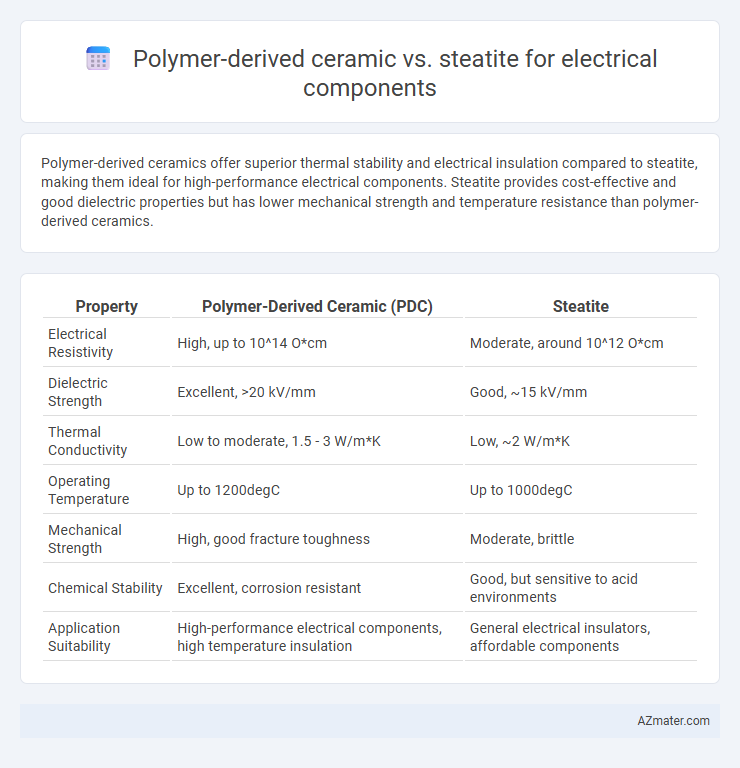Polymer-derived ceramics offer superior thermal stability and electrical insulation compared to steatite, making them ideal for high-performance electrical components. Steatite provides cost-effective and good dielectric properties but has lower mechanical strength and temperature resistance than polymer-derived ceramics.
Table of Comparison
| Property | Polymer-Derived Ceramic (PDC) | Steatite |
|---|---|---|
| Electrical Resistivity | High, up to 10^14 O*cm | Moderate, around 10^12 O*cm |
| Dielectric Strength | Excellent, >20 kV/mm | Good, ~15 kV/mm |
| Thermal Conductivity | Low to moderate, 1.5 - 3 W/m*K | Low, ~2 W/m*K |
| Operating Temperature | Up to 1200degC | Up to 1000degC |
| Mechanical Strength | High, good fracture toughness | Moderate, brittle |
| Chemical Stability | Excellent, corrosion resistant | Good, but sensitive to acid environments |
| Application Suitability | High-performance electrical components, high temperature insulation | General electrical insulators, affordable components |
Introduction to Electrical Ceramics
Polymer-derived ceramics (PDCs) offer superior thermal stability and high dielectric strength compared to traditional steatite, making them ideal for advanced electrical components. Steatite, a magnesium-rich ceramic, provides excellent insulation properties and cost-effectiveness but has lower mechanical strength and thermal resistance. Electrical ceramics require materials with optimized dielectric constant, electrical resistivity, and mechanical durability, where PDCs increasingly outperform steatite in high-frequency and high-temperature applications.
Overview of Polymer-Derived Ceramics
Polymer-derived ceramics (PDCs) are advanced materials synthesized through the pyrolysis of preceramic polymers, offering superior thermal stability and electrical insulation compared to traditional steatite ceramics. PDCs exhibit excellent dielectric properties, high chemical resistance, and the ability to maintain structural integrity at elevated temperatures, making them ideal for high-performance electrical components. Unlike steatite, which is a naturally occurring clay-based ceramic with moderate electrical insulating properties, PDCs provide enhanced customization in composition and microstructure, enabling tailored electrical and mechanical characteristics.
Defining Steatite and Its Applications
Steatite, a magnesium silicate ceramic known for its excellent electrical insulation and thermal stability, is widely used in electrical components such as insulators, substrates, and spark plugs. Its high dielectric strength and resistance to thermal shock make it ideal for applications requiring reliable performance under high voltage and temperature fluctuations. Compared to polymer-derived ceramics, steatite offers superior mechanical robustness but may lack the advanced tunability and lightweight characteristics of polymer-based alternatives.
Mechanical Properties Comparison
Polymer-derived ceramics (PDCs) exhibit superior mechanical properties compared to steatite, including higher fracture toughness and greater flexural strength, making them more resilient in demanding electrical applications. PDCs benefit from enhanced thermal stability and inherent resistance to microcracking, which contributes to sustained mechanical performance under thermal cycling. Steatite, while offering good electrical insulation and machinability, generally shows lower mechanical robustness and brittleness, limiting its use in high-stress environments.
Dielectric Performance Analysis
Polymer-derived ceramics exhibit superior dielectric properties compared to steatite, including higher dielectric strength and lower dielectric loss, making them ideal for high-frequency electrical components. Steatite, primarily composed of magnesium silicate, offers moderate dielectric constant values but generally falls short in temperature stability and breakdown voltage when compared to polymer-derived ceramics. Advanced dielectric performance analysis highlights that polymer-derived ceramics maintain consistent capacitance and insulation resistance under thermal stress, outperforming steatite in reliability for demanding electronic applications.
Thermal Stability and Conductivity
Polymer-derived ceramics exhibit superior thermal stability, maintaining structural integrity at temperatures exceeding 1600degC, compared to steatite's effective range up to 1000degC. Their enhanced thermal conductivity, typically around 15-25 W/m*K, outperforms steatite, which has lower conductivity values near 5 W/m*K, enabling better heat dissipation in electrical components. These properties make polymer-derived ceramics more suitable for high-temperature, high-performance electrical applications requiring reliable thermal management.
Manufacturing Processes and Scalability
Polymer-derived ceramics offer versatile manufacturing processes such as additive manufacturing and low-temperature crosslinking, enabling complex geometries and rapid prototyping for electrical components. Steatite ceramics rely on traditional powder pressing and sintering methods, which are well-established but less adaptable to intricate designs and rapid scalability. The scalability of polymer-derived ceramics benefits from flexible synthesis and shaping techniques, whereas steatite production excels in high-volume, cost-effective manufacturing with consistent dielectric properties.
Cost-Efficiency and Market Availability
Polymer-derived ceramics exhibit high cost-efficiency due to lower raw material expenses and scalable manufacturing processes compared to steatite, which relies on more expensive mining and processing operations. The market availability of polymer-derived ceramics is rapidly expanding as advancements in polymer chemistry enable consistent production of customized electrical components, while steatite faces limitations from geographical deposits and fluctuating supply chains. Cost-efficiency and widespread availability position polymer-derived ceramics as a more viable choice for modern electrical component applications.
Environmental and Long-Term Reliability
Polymer-derived ceramics (PDCs) exhibit superior environmental stability and long-term reliability compared to steatite, due to their excellent thermal resistance and low dielectric loss under harsh conditions. PDCs maintain structural integrity and electrical performance in high-temperature and corrosive environments, making them ideal for advanced electrical components requiring durability. In contrast, steatite, while cost-effective and electrically insulating, suffers from moisture absorption and mechanical degradation over time, which can compromise insulation properties and device longevity.
Application Suitability: Choosing the Right Material
Polymer-derived ceramics excel in high-temperature and high-voltage electrical components due to their superior thermal stability and electrical insulation properties, making them ideal for advanced semiconductor packaging and electronic substrates. Steatite, known for its excellent dielectric strength and mechanical robustness, is commonly used in standard insulating components and high-frequency applications where cost-effectiveness and ease of machining are critical. Selecting the appropriate material hinges on the specific application requirements such as operating temperature, electrical stress, and mechanical durability to ensure optimal performance and longevity.

Infographic: Polymer-derived ceramic vs Steatite for Electrical component
 azmater.com
azmater.com